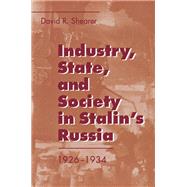Industry, State, and Society in Stalin's Russia, 1926–1934
, by David R. Shearer- ISBN: 9780801483851 | 0801483859
- Cover: Nonspecific Binding
- Copyright: 9/5/2018
In his reexamination of the origins of the Stalinist state during the formative period of rapid industrialization in the late 1920s and early 1930s, David R. Shearer argues that a centralized state-controlled economic system was the consciously conceived political creation of Stalinist leaders rather than the inevitable by-product of socialist industrialization.
Focusing on the different economic and bureaucratic cultures within the industrial system, Shearer reconstructs the debate in 1928 and 1929 over administrative, financial, and commercial reform. He uses information from recently opened archives to show that attempts by the state's trading organizations to create a commercial economy enjoyed wide support, offering a model that combined planning and rapid industrialization with social democracy and economic prosperity. In an effort to crush the syndicate movement and establish tight political control over the economy, Stalinist leaders intervened with a program of radical reforms. Shearer demonstrates that many professional engineers, planners, and industrial administrators actively supported the creation of a powerful industrial state unhampered by domestic social and economic constraints.
The paradoxical result, Shearer shows, was a loss of control. The overly centralized system that emerged during the first five-year plan was rendered incoherent by periodic economic crises and the continuing influence of partially suppressed social and market forces.
Focusing on the different economic and bureaucratic cultures within the industrial system, Shearer reconstructs the debate in 1928 and 1929 over administrative, financial, and commercial reform. He uses information from recently opened archives to show that attempts by the state's trading organizations to create a commercial economy enjoyed wide support, offering a model that combined planning and rapid industrialization with social democracy and economic prosperity. In an effort to crush the syndicate movement and establish tight political control over the economy, Stalinist leaders intervened with a program of radical reforms. Shearer demonstrates that many professional engineers, planners, and industrial administrators actively supported the creation of a powerful industrial state unhampered by domestic social and economic constraints.
The paradoxical result, Shearer shows, was a loss of control. The overly centralized system that emerged during the first five-year plan was rendered incoherent by periodic economic crises and the continuing influence of partially suppressed social and market forces.






